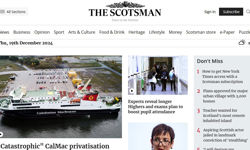With a recent increase in investment and development, the North East has rapidly evolved into a hotbed of cultural activity. Already acknowledged as the region's leading voice on arts and entertainment coverage, the Journal recognised an opportunity not to be missed. With the right product we could build on our current reputation, and position ourselves at the heart of this cultural renaissance. We could use our voice to celebrate what our region has to offer, encourage the people of the North East to get more involved in cultural activities, and, at the same time, strengthen our own business by maximising newspaper sales opportunities.
Strategy
How could we best capitalise on this opportunity? The solution came in the form of a three tiered strategy. We would produce a monthly glossy Culture magazine, including a comprehensive listings section, launch an annual awards ceremony to celebrate the region's cultural achievements and develop some sort of interactive readers club. The first two strands were relatively easy to develop as we already had a dedicated editorial team producing high quality arts coverage and a high profile regional events team. Development of the club was to prove much more difficult.
From research, we knew that a large percentage of the local population was not engaging with the cultural facilities within the region. Although we were not sure what sort of format the club would take, we knew that it had to fulfil certain aims. It had to encourage people to get more involved in cultural activities, give them the opportunity to try something new and, in turn, build new audiences for organisations and venues in the North East.
By working closely with Arts Council England and conducting thorough research into the current marketplace, we realised that the concept was completely new and nothing like this existed. Sure, there were plenty of schemes offering money saving promotions and percentage discounts on cultural activities, but there was nothing that went beyond that. It was clear that if we were to secure the co-operation of arts organisations in the region, we would have to make sure our product delivered much, much more. But how were we going to do it? We decided that our product had to look good, feel good and offer value for money.
Brand identity
We started by developing a dynamic brand for the club - a strong image that we could use to build brand identity. We were conscious that the Journal brand and reputation would not only be crucial in gaining support from arts organisations, but would also be instrumental in giving members the confidence to sign up to a completely new concept. The Journal name had to be an integral part of the product design, but we didn’t want it to dominate. For the logo, we decided on a 3-colour combination of orange, black and white - contemporary, striking but a far cry from our traditional Journal blue. As soon as we had our ‘look’ we started filtering the brand into the local media. We began with a teaser campaign in our regional newspaper titles, using the logo coupled with a ‘coming soon’ tagline. We also took advantage of current contra deals with other regional organisations to draw attention to the Culture Club launch. We secured advertising sites on Nexus metro carriages and branded up over a million Metro Radio Arena concert tickets.
The mechanics
Next came the actual mechanics of how the club would work. We had a vague concept of what we wanted to do, but we had to come up with a detailed, viable and cost effective plan. We had to come up with a product that served the arts organisations we would be working with, provided members with an exclusive service and simultaneously allowed us to increase newspaper sales and encourage loyalty to the Journal.
The long-term strategy was to work with organisations and venues in the region to create exclusive Culture Club events and provide 'money-can’t-buy opportunities'. We would publish these benefits on a weekly Culture Club page in the Journal, encouraging members to purchase a copy of the paper to discover the latest deals and events. In theory, this seemed like a simple idea – however, without members, organising events would be impossible. First of all, we needed to recruit.
Setting the price
Attaching a price to the product would not only help us raise the revenue to support the scheme, but would also help the consumer realise the value of the product and convince them that they were getting something substantial for their money. After much deliberation, we decided on £10 for the annual membership. We felt that this figure was affordable and a reasonable price for what we would offer, but we were conscious that we would have to create a fantastic product to persuade the public to part with their cash. We also knew that if we were charging for the product we would have to give people an incentive to join – we would struggle to persuade them to sign up on the mere promise of a weekly offering of special offers and events. We had to demonstrate an immediate gain or reward.
To that end, we put together a package of standard Culture Club offers that members could enjoy throughout their period of membership. We approached cultural venues and facilities in the region and came up with over 30 money saving offers. These included discounts on holidays, food and drinks, museum entrance fees, cinema tickets and much, much more. Once the offers had been negotiated, our in-house designer packaged them into a high quality 60-page brochure that each member would receive once they had signed up. Our product was slowly taking shape.
Offline and online
We decided to create a dual subscription process. People could choose to fill in an application form in print format (either printed in the paper or available from carefully selected venues) or they could sign up online on a specially created website. We provided our digital team with a specific brief and they came up with a branded site that allowed us to display club information (including standard offers and the programme of weekly promotions and events) and a subscription facility with secure online payment. It was also imperative that we were able to update the site regularly and have an archive facility to document all promotions and events. We knew that the website would become a valuable addition to our print product so we monitored its progress carefully. It would allow us to drive traffic from the site to a particular edition of the newspaper but in turn we could also direct print readers back to the site to access further information.
Database marketing opportunities
In answer to our brief, the team also developed a database that would sit behind the website. This would store all member information and allow us to track member activity. We would be able to build up complex member profiles in terms of location, interests and cultural habits. From talking to arts organizations, we knew it would be this facility that would prove invaluable in persuading them to provide opportunities and events for our members. Developed and maintained correctly, our database would become an important tool in audience development - vital in today’s cultural and economic climate.
Once a member had signed up, they would be given a unique membership number, which they would be asked to quote when applying for tickets, entering competitions or attending special events. To add value to the overall package, and to make it easy for members, we produced high quality personalised membership cards that they could use to prove that they were club members.
The launch
Once the standard offers had been negotiated, the brochures and cards printed and the application forms ready to be completed by eager ‘would be’ members we were almost ready to launch the club. A two-week pre-promotional campaign was carried out in associated NCJ Media titles, culminating in a double page editorial launch spread in the Journal - complete with a dynamic front-page splash. We asked key cultural figures and celebrities to endorse the club, listed all Culture Club benefits, included an application form, and within six weeks we had over 500 members.
Since the launch, the Culture Club has gone from strength to strength. Once we had recruited members, we were able to arrange a full programme of weekly offers, promotions and special events. We have worked with hundreds of organisations, and members have enjoyed guided walks, wine tasting, cooking demonstrations, special behind-the-scenes tours, been able to meet key cultural figures, attended book signings and much, much more. Members have saved hundreds of pounds through using the many offers, visited venues that they have never been to and enjoyed activities that they would never have tried on their own. We regularly communicate with them through email, SMS text and in person. Twelve months on, we have over 1600 members and counting.
The club is mainly funded through membership fees, but since its launch it has attracted investment from the Sponsors Club for Arts & Business and One North East - a regional development agency - has recently become our primary sponsor.
The Journal Culture Club is an innovative new initiative allowing many different parts of the business to work together. It incorporates both print and online media, and provides an alternative revenue stream. Not only does it support cultural venues and organisations in the region, but it also plays a vital part in developing new audiences. On an ongoing basis, the club creates product loyalty and strengthens the existing Journal brand.
FEATURE
Culture Club
At the 2006 Newspaper Society Conference, the Promotional Campaign of the Year award went to the Newcastle Journal for its Culture Club – a brilliant fusion of offline and online activity built on the back of the burgeoning local arts scene. Here, the Journal’s Rachel Suddart talks us through their launch strategy.










